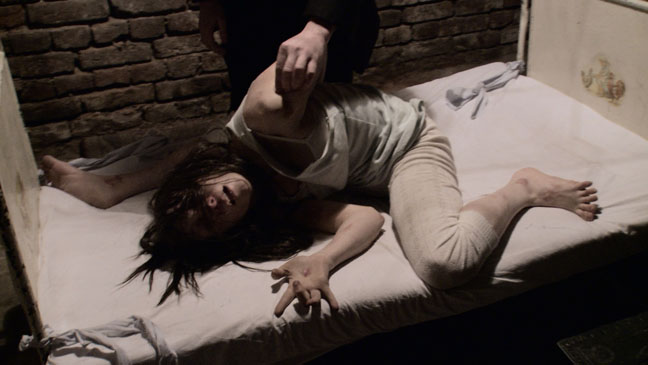With all movies (barring documentary) we, as viewers, are aware that what we are seeing is not true. We know the “sender” is telling us an elaborate lie — a story — and we have to suspense our ability to disbelieve in order to fully immerse ourselves in a movie-watching experience. Horror is especially adept at crafting this lie: Paranormal Activity, The Blair Witch Project, and a variety of other movies play on the idea of “found film” so make what we’re viewing so much more real. But it’s not enough to merely give the viewer these “recordings,” a viewer must be able to relate, to read all the signs, in order to feel the true impact of a horror film.
I wanted to look not at a concept of horror film for this entry, but at a film itself. I’ve previously discussed the fear of the unknown, the use of religious images, and the use of color in horror. The Devil Inside uses all of these concepts and far more in its story, and while neither the best nor my favorite film (I found it mostly middle-ground in terms of horror), I decided to look at how symbols and semiotic concepts are used, specifically, in this film.

Also, it was available on Netflix.
The film begins with a purposeful attempt to blur the lines of reality. This is not just found footage: We are shown crime scene footage (quite dark, despite being in a house, where lights exist — but camera-flashlights add so much tension!), and a clip from a newscast before centering in on an interview with Isabella Rossi, the daughter of the woman who committed the murders from the crime scene footage. All fake, and all carefully crafted, the film wants us to believe we are watching a documentary, even when falling on some of the most commonly stereotypical horror tropes. (At the end of the crime scene footage there is an unknown sound before the camera cuts away. Spooooooky.) It wants to create that fear of the unknown, somethings expanded upon even farther as the film begins: We see a broken chair, a dead priest, and a woman clutching a cross before we hear the words “exorcism.” Even without seeing a preview, the film makes use of painfully obvious symbols to foreshadow the overall point of the movie. It does this far more subtly, a number of minutes in, as Isabella sits in on a class at the Vatican School of Exorcism (not a real school), and we conveniently hear mention of the transference of demons. Gee, I wonder what will happen later. It’s in these beginning scenes that the film sets the stage for it’s own mythos and intratextuality that we need to accept as viewers. Without our relation to these first moments of film, the rest of the movie would not work.
There are also times where the movie relies heavily on color — although these scenes are few. When Isabella goes to visit her mother in the mental hospital, we see camera footage of her mother. The film appears black-and-white, but for the dull color of a yellow chair. Incidental? Maybe, but also perhaps a moment of calm brightness to contrast the next color in the scene, which is the red of blood, standing out even brighter. The scenes in the hospital themselves are nothing special: The video is dull, normal “found footage”-style fair, which doesn’t seem the match the crisp realness of the other documentary camera moments, but does work to show the somber nature of a mental hospital.
Shortly after that first hospital visit, we are shown a mash-up, of sorts. Isabella voices over what it’s like to effectively lose both her parents. As she does this the video switches between Isabella walking by herself in crowds of people, religious imagery, statues that represent loneliness. These images are quick moments, the get us a feeling of loss and being lost. Even though she has a camera man/documentarian with her, Isabella is alone. She has no parents, no hint of a significant other, and it is earlier-hinted that she has had an abortion, which could be a symbol of literal emptiness insider her. A similar voice-over mash-up moment happens shortly after when a young priest discusses his background with exorcisms.
This film also falls back on the perversion of religion. “Inverted crosses, commonly used in Satanic rituals.” But we’ve already discussed the problem with that. Later we move on to a young girl possessed by a demon, containing some more apparent symbols: “She’s getting worse,” her mother warns, saying she moved her to the basement. She’s getting worse, so she is physically getting lower, getting put in a dark, dank space, and closer to Hell.

It’s here we get to view our first “real,” brutal exorcism and demonic possession. And the demon shows in the young girl’s body: She is contorted and ugly, marked by bruises, blood, and dirt. The demon is not elegant, and neither is this girl. She wears her possession like a gown, so the characters and the viewers both can understand that even if the Devil can be subtle, smooth, and resort to trickery, demons are rough and obvious. They make a normally-pretty girl physically “wrong.”
These themes continue throughout the movie, mimicked in obvious and more subtle ways–generally the more obvious. This is not a movie with symbols twined in like a delicate thread, but it is still not a movie without its symbols. It is also a movie who keeps to one solid plot, and the later hospital scene and later exorcism are so similar to the one we see in the first half there is no need to reiterate. A choice that perhaps does not make for the most frightening of films, but does at least hold true to it’s own setting, and is a good example of common symbols and semiotics in horror film.

